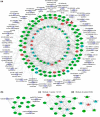TMT-based comprehensive proteomic profiling identifies serum prognostic signatures of acute myeloid leukemia
- PMID: 37016705
- PMCID: PMC10066874
- DOI: 10.1515/med-2022-0602
TMT-based comprehensive proteomic profiling identifies serum prognostic signatures of acute myeloid leukemia
Abstract
Acute myeloid leukemia (AML) is classified into favorable-risk, intermediate-risk, and poor-risk subtypes. This study aimed to compare the serum proteomic signatures of the three AML subtypes and identify prognostic biomarkers for AML. Serum samples from patients with favorable-risk (n = 14), intermediate-risk (n = 19), and poor-risk AMLs (n = 18) were used for the analysis of tandem mass tag (TMT) labeling-based quantitative proteomics. Comparative analysis was performed to identify differentially expressed proteins (DEPs) between groups. Prognostic proteins were screened using binary logistics regression analysis. TMT-MS/MS proteomics analysis identified 138 DEPs. Fumarate hydratase (FH), isocitrate dehydrogenase 2 (IDH2), and enolase 1 (ENO1) were significantly upregulated in poor-risk patients compared with favorable-risk patients. ELISA assay confirmed that patients with poor-risk AMLs had higher levels of IDH2, ENO1, and FH compared with intermediate-risk AML patients. Logistics analysis identified that proteins 3-hydroxyacyl-CoA dehydrogenase type-2 (HADH, odds ratio (OR) = 1.035, p = 0.010), glutamine synthetase (GLUL, OR = 1.022, p = 0.039), and lactotransferrin (LTF, OR = 1.1224, p = 0.016) were associated with poor prognosis, and proteins ENO1 (OR = 1.154, p = 0.053), FH (OR = 1.043, p = 0.059), and IDH2 (OR = 3.350, p = 0.055) were associated with AML prognosis. This study showed that AML patients had elevated levels of FH, IDH2, ENO1, LTF, and GLUL proteins and might be at high risk of poor prognosis.
Keywords: TMT labeling-based quantitative proteomics; favorable-risk acute myeloid leukemia; isocitrate dehydrogenase 2; prognostic biomarker; proteomic profiling.
© 2023 the author(s), published by De Gruyter.
Conflict of interest statement
Conflict of interest: None.
Figures




Similar articles
-
IDH1 and IDH2 mutations are frequent genetic alterations in acute myeloid leukemia and confer adverse prognosis in cytogenetically normal acute myeloid leukemia with NPM1 mutation without FLT3 internal tandem duplication.J Clin Oncol. 2010 Aug 1;28(22):3636-43. doi: 10.1200/JCO.2010.28.3762. Epub 2010 Jun 21. J Clin Oncol. 2010. PMID: 20567020
-
Quantitative proteomic analysis of human plasma using tandem mass tags to identify novel biomarkers for herpes zoster.J Proteomics. 2020 Aug 15;225:103879. doi: 10.1016/j.jprot.2020.103879. Epub 2020 Jun 30. J Proteomics. 2020. PMID: 32585426
-
Prognostic impact of isocitrate dehydrogenase enzyme isoforms 1 and 2 mutations in acute myeloid leukemia: a study by the Acute Leukemia French Association group.J Clin Oncol. 2010 Aug 10;28(23):3717-23. doi: 10.1200/JCO.2010.28.2285. Epub 2010 Jul 12. J Clin Oncol. 2010. PMID: 20625116
-
[Research Advances of IDH2 Gene Mutation in Acute Myeloid Leukemia].Zhongguo Shi Yan Xue Ye Xue Za Zhi. 2016 Apr;24(2):632-6. doi: 10.7534/j.issn.1009-2137.2016.02.061. Zhongguo Shi Yan Xue Ye Xue Za Zhi. 2016. PMID: 27151043 Review. Chinese.
-
Targeting the IDH2 Pathway in Acute Myeloid Leukemia.Clin Cancer Res. 2018 Oct 15;24(20):4931-4936. doi: 10.1158/1078-0432.CCR-18-0536. Epub 2018 May 16. Clin Cancer Res. 2018. PMID: 29769206 Review.
Cited by
-
Single-cell dissection reveals promotive role of ENO1 in leukemia stem cell self-renewal and chemoresistance in acute myeloid leukemia.Stem Cell Res Ther. 2024 Oct 8;15(1):347. doi: 10.1186/s13287-024-03969-w. Stem Cell Res Ther. 2024. PMID: 39380054 Free PMC article.
-
High Expression of ENO1 and Low Levels of Circulating Anti-ENO1 Autoantibodies in Patients with Myelodysplastic Neoplasms and Acute Myeloid Leukaemia.Cancers (Basel). 2024 Feb 22;16(5):884. doi: 10.3390/cancers16050884. Cancers (Basel). 2024. PMID: 38473245 Free PMC article.
-
Application of omics in the diagnosis, prognosis, and treatment of acute myeloid leukemia.Biomark Res. 2024 Jun 10;12(1):60. doi: 10.1186/s40364-024-00600-1. Biomark Res. 2024. PMID: 38858750 Free PMC article. Review.
References
-
- Network NCC. Acute myeloid leukemia. national comprehensive cancer network clinical practice guidelines in oncology–V2.2016. National Comprehensive Cancer Network; 2016. http://www.nccn.org/professionals/physician_gls/pdf/aml.pdf. Accessed October 2016.
LinkOut - more resources
Full Text Sources
Miscellaneous
